South Korea and Iran take plaudits in Groups C & D
Having kept my exploring to a minimum over the first couple of days, I finally got to walk part way down the Corniche on Monday morning. This is long curving bay is over three miles long, with my hotel and the new constructions at one end, while the older town is at the other. For the whole length, there is a dual carriageway road between the Corniche and any buildings, whereas on the seaside of the road, there is an expanse of grass, and a paved walkway next to the sea wall. Although the waters are very shallow, there is no access to the sea, or any beaches within the city.
At my end of the walk, where the gleaming new skyscrapers compete for attention, the effect can be quite spectacular, although at all times one can hear the steady noises of construction, reminding you that much of this area is incomplete. Once clear of this area, though, there is little around you, and no places to stop until the half way point, where there is some type of restaurant, and an Asian Cup sales booth.
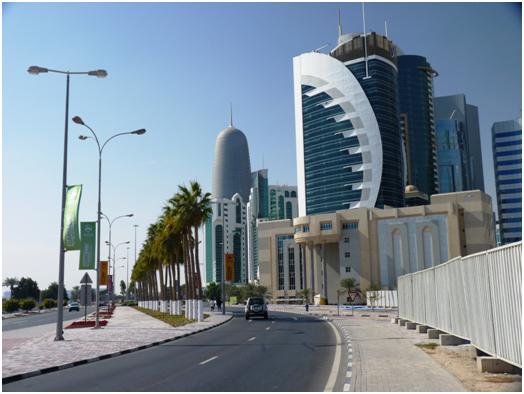
At this point, we meet up (by chance) with Rob, who is fresh in from the airport, having not even checked into his hotel. He is picking up match tickets for eight games over a four day period. Paul and Kevin are trying to find their tickets for the rest of the tournament, and although the rigmarole of buying the tickets is long winded and slow, this is completed, with the exception that we are told the first game on the list Australia v India at Al Sadd is sold out.
This is a blow, as it is the only time we intended to go to this ground; and it is resolved to reach the stadium early in the hope tickets will become available.
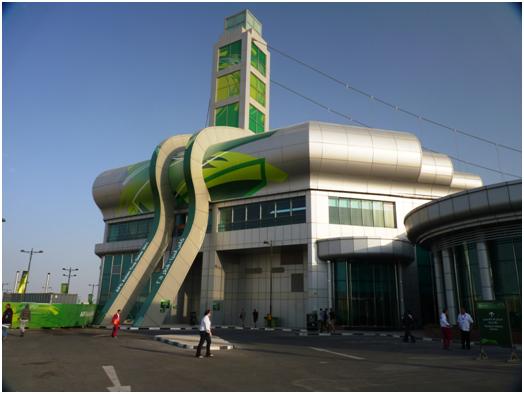
The Stadium at Al-Sadd, seen from the outside
However, it is too early to be early, so we take a taxi to the Souq Waqif, further along the Corniche. Here we stop for a coffee and a snack from a Lebanese styled coffee shop. I think the person serving was from Bangladesh. We looked around the souk a little, but it had none of the hustle and bustle of say, its equivalent in Tunis. It does not appear to be greatly in use by the locals, and as a tourist trap, it would be better placed in a country that welcomes more tourists. It is in fact, the row of coffee shops and restaurants that runs down a wide street through the middle that brings the customers in.
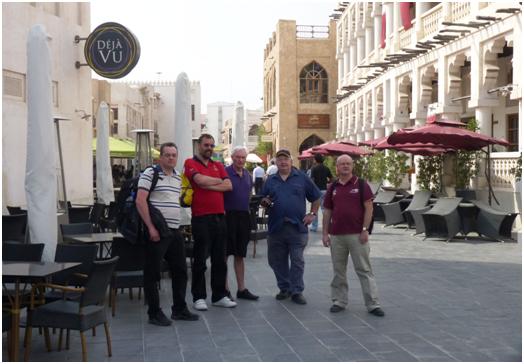
Englishmen Abroad from left, Rob, Kevin, John, Ratty and Paul
When we looked a little closer, we concluded that it was in fact a faux souq, recently renovated to look as visitors may expect a souq to look, but if the stall holders are not calling out for the custom of those passing by, (and indeed few are passing by), then it really does not have the feel to it.
The locals are more likely to be found in the mega shopping malls, which look the same here as any other city in the world, and with the same shops and fast food joints in most, they need some other feature to bring the consumer in. There is one near the main stadium and it is made to look like an old Italian town with a reminder of Venice as “Gondolas” float down a central “Canal”. The ceilings are painted as blue sky with clouds, which gives a strange feeling when one steps inside after dark.

Inside the Mall, balloons stick to the painted ceiling
There is a lack of description here for games five and six, due to a computer fault, and the rather basic fact that they deserve little description. What does need to be mentioned is the Jassad bin Hamad Stadium, home of Al-Sadd.
This is a neat and very attractive modern stadium. All four sides are square to the pitch, and there is a single tier of seats which gives way only to the VIP areas on the main side. Well, to be accurate, VIP is now the highest price for tickets for ordinary mortals, the sponsors and invited guests here are promoted to be VVIPs. I am sure there is some special category for Sheiks and Sepp Blatter, more initials? Or just self proclaimed Gods?
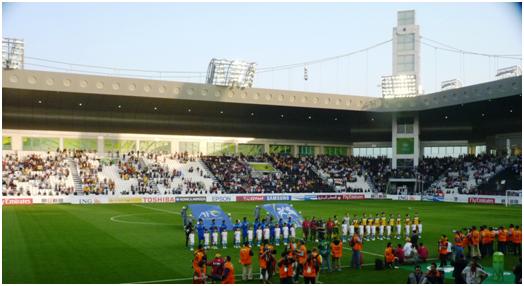
The roof with covers all sides of the ground is glad in what appears to be metal, painted in metallic grey. The cladding is both under and over any superstructure, given the impression of a solid roof, that would be around half a meter thick!. The only support visible is cables hanging from four corner pillars, while the floodlights are on squat pylons coming out of the roof, and apparently trying to peer over the edge.
I must say I liked the ground, although for an international tournament, it is on the small side. Different sources place it at either 12,500 or 13,500 seats; which may mean it is the smallest of the stadia. Qatar Sports Club has been listed as between 12,500 and 15,000. [As they appear identical, I would assume Al Rayyan and Al Gharafa both hold the same number, around 25,000, whereas Khalifa supposedly held 50,000 for England, but a near capacity 25,000 for the opening game].
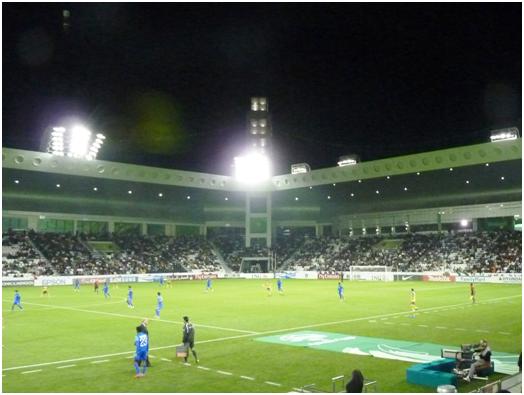
Al-Sadd’s ground is supposedly a cooled stadium. I am not sure exactly what this means, (it is not roofed), but I noticed some type of vent under every seat, so I assume cold air can be pumped through. This was entirely unnecessary in the cool January afternoon. When the ticketless arrived at the stadium, they were told that none were on sale, but there might be some available later. However, they managed to persuade the ticket office to call the stadium manager, and get tickets released. When the final figures were announced, it turned out that some 3000 seats (25% or more) were empty. The official figure was 9783.
In the following day’s paper, the AFC were appealing for more people to come to the games, but there was no explanation of how to achieve this when tickets are not offered for sale!
The majority of the support were Indians, this being one of the largest population of expats in Qatar. However, their team was never likely to do them proud, and the match was a cakewalk for Australia. A win by four goals was hardly a satisfactory result considering their dominance, but they appeared to declare in the second half. Tim Cahill got two of the goals, Harry Kewell and Brett Holman the others. The test for Australia will be the second game, when they play South Korea.
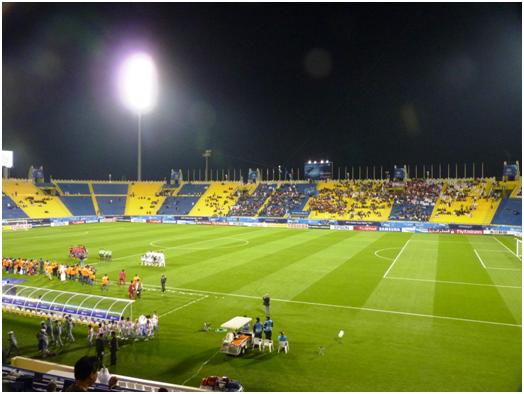
Having visited all five stadiums for the first five games, match six was the first to get a repeat visit. The match was South Korea v Bahrain at Al Gharafa. No problems getting tickets here, with a crowd of just 6669. Bahrain may lie not far from the coast of Qatar, but this has not persuaded their fans to travel over in great numbers. If they had done, they would not have been impressed, except in the final few minutes. South Korea spent most of the game well in the comfort zone, and Koo Cha Cheol scored just before and after the half time break to give them a two goal lead. It was only after a foul by Kwak Tae Hwi with five minutes to go that Bahrain found any hope. The Korean was sent off, and Faouzi Aaish converted the penalty. This meant a few nervous minutes for South Korea, as they ran down the clock, but they held on to the 2-1 victory.
The Group D matches saw us repeat the travelling options from two days previously, starting at Qatar Sports Club where North Korea were taking on UAE, and then going back to Al Rayyan to see the Iran-Iraq clash.
North Korea had an early chance to take the lead, following a clumsy challenge by Hamdan Al Kamali on Jong Tae Se. Hong Yong Jo stepped up and hit the penalty against the bar. Hong Yong Jo is one of three North Korean born players who play their football abroad, he has been at Rostov, while two others play for Wil in Switzerland. The team also includes three Japanese born Koreans, two of which play in Japan while Jong Tae Se is with VfL Bochum.
The North Korean fans, who all sat together in a block, all wearing shirt and tie, appeared to be the champions of a synchronised cheering contest. Led by a cheerleader, who saw little of the game, they almost all held small North Korean flags and waved them in unison
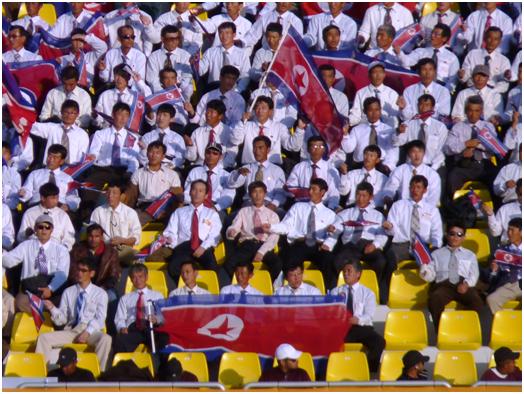
Wave to the Right, Please
UAE had very little to show in the first twenty-five minutes, but then Korean keeper needed to make a sharpish save when Ismaeil Matar received the loose ball after a defensive error, and they started to get more into the game and had several close shots.
Somewhat to our surprise, the North Korean fans were somewhat tardy in taking their seats at the start of the second half, leading us to wonder whether there had been mass defections, or if they might suffer criticism for a failing in their synchronised flag waving, once back in Pyongyang.
Meanwhile a long shot from Matar goes narrowly over the bar as UAE start the strongest in the second half. The game gradually slows down and by the time there are 20 minutes to play we are all resigned to it remaining scoreless.
This time the journey to Al Rayyan is less tense than two nights previously. Although a taxi I had booked had called me back to say he would not make it, Paul and Rob found a row of cabs waiting as they left the stadium. Paul sat in the taxi to claim, while Rob came looking for Steve and myself. Although by the time we reached the point the cabs had been waiting, it had been moved along by the police, Paul persuaded the taxi to circle the stadium, catching us up just before we may have given up. We arrived nearly thirty minutes before kick off.
The second game started in a lively manner with chances at both ends, and we did not have to wait long for a goal. A 13th minute cross to the far post was met by Emad Mohammed Ridha who headed towards goal. The score was accredited to him, although it appeared that Younnus Mohmood (who had scored the goal in the final, four years ago) got a boot to the ball before it could cross the line. Emad, incidentally plays his club football in Iran. Iran levelled things in the 41st minute when Teymourian found Rezaei just onside and needing only a step to pass a defender before shooting in from the right. Naturally, Iraq came back strongly, and Rahmati had to make two saves from a Ala’a Abdulzehra header and a Samal Saeed long shot before the break.
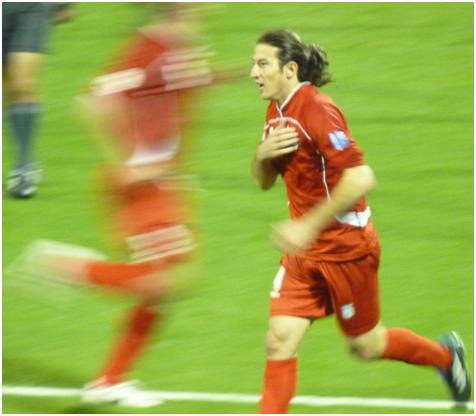
Former Bolton player Andranik Teymourian celebrates the Iranian equaliser
Iraq started the second half with Samal Saeed shooting over after meeting a corner headed on by Younnis, while minutes later Mohammed Kassid had to be alert to fend off corners at the other end. Iran began to take control as the game moved on, Rezaei on the right wing keeping the ball moving and sending in threatening crosses, while two big centre halves pushed up and looked threatening whenever there was a corner or an opportunity for a long throw.
Although it seemed that Iran were in control, this had the potential to be fleeting, and it took a good block by Nosrati to stop Younnis putting Iraq ahead in the 70th minute. On 75 minutes, a chance fell to Rezaei, but he could only place the ball into the side netting. Iran finally got the breakthrough on 84 minutes, a tug on substitute Khalatabari’s shirt gave Iran a free kick, wide on the left wing, and a deceptively curving shot from Iman Mobili was missed by everyone as it found its way into the net. Iran should have increased on the lead when Hadi Aghili headed a free kick over the bar.
With the match complete, we had now seen all 16 teams in their opening games. The best games were the Iran Iraq and Syria Saudi Arabia matches, but no clear favourite for the title has emerged. The South Koreans certainly look strong, while the Japanese seemed a little unprepared. With the win against Iraq under their belt, Iran also may also fancy their chances. The local teams present a different puzzle. One of the coaches went as far as to comment on the fact that not one of the teams who had competed in the previous month’s Arabian Gulf Cup had won their opening game in this tournament. Six teams play in both tournaments.
It is safe to say that more than half the coaches from this tournament will change jobs or at least become unemployed before long, but Saudi Arabia’s Jose Peseiro left quicker than most, receiving his marching orders after just one match.